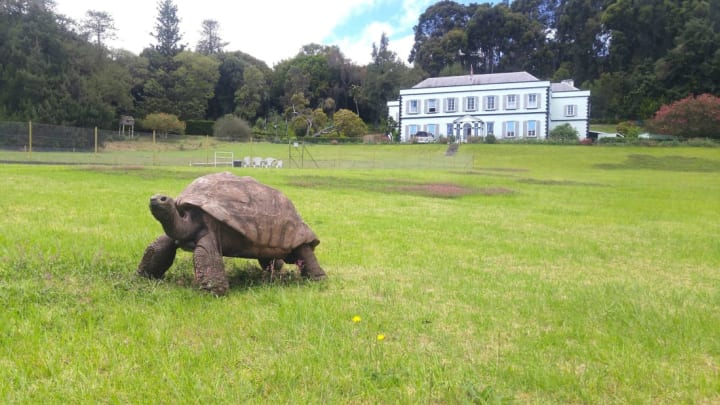Figuring out which animals are longest-lived is tricky, because some game the system. Immortal jellyfish, for example, clone themselves in their juvenile polyp stage, a phase to which they can return later in life. It’s a jaw-dropping feat—but is it the same jellyfish or a newborn copy?
Suspended animation is another loophole. According to a recent study in Current Biology, scientists thawed microscopic rotifers—which had been in a state of cryptobiosis in Siberian permafrost for 24,000 years—that started asexually reproducing like it was their morning routine.
Taking such outliers into consideration, here are the animals that will probably get the most free birthday scoops from Baskin-Robbins in their super-long lifetimes.
Table Of Contents
- 1. Deep Sea Sponges // 2300-18,000 years
- 2. Greenland Shark // 400-500 years
- 3. Ocean Quahog // 200-500 years
- 4. Bowhead Whale // 200 years
- 5. Rockfish // 100-200 years
- 6. Red Sea Urchin // 100-200 years
- 7. Aldabra Giant Tortoise // 189 years and counting
1. Deep Sea Sponges // 2300-18,000 years
A species of deep sea glass sponge (Monorhaphis chuni) produces an extremely long spicule, or skeletal structure, made of silica, with the sponge part on the top. It looks a bit like an artsy floor lamp. Much like tree rings, the layers of silica record climate fluctuations as well as the age of the animal. A 2017 study of ocean composition over time that included M. chuni spicules estimated they were between 5000 and 18,000 years old.
In 2008, another study looking at the growth rate of the giant barrel sponge (Xestospongia muta) estimated they can live more than 2300 years.
2. Greenland Shark // 400-500 years

Though they’re slow-moving and usually blinded by eye parasites, Greenland sharks (Somniosus microcephalus) are still one of the top predators in the Arctic and the world’s longest-lived vertebrates. A 2016 study on a 16-foot Greenland shark, which was caught in fishing nets as bycatch, used a new technique to date the animal. By radiocarbon-dating a protein inside their eyes, which forms before birth and remains viable throughout their lives, scientists estimated the specimen was about 392 years old, give or take 120 years. That suggests the sharks can live between 272 and 512 years.
3. Ocean Quahog // 200-500 years
These cold-water clams (Arctica islandica) often live well over 200 years [PDF]. The oldest known individual was a mature 507-year-old named Ming the Mollusk, collected by research scientists from the Icelandic shelf in 2006. Age in quahogs is determined by counting the lines on the shell, some of which are extremely fine, and Ming’s true age was not determined until 2013 by researchers at Bangor University in the UK. The animal would have born in 1499, at the time of the Ming Dynasty, hence its nickname.
More Articles About Animals:
4. Bowhead Whale // 200 years

Analyzing stone harpoon tips found in the blubber of bowhead whales (Balaena mysticetus) is one of the ways scientists have determined they can live up to two centuries. Biologists working with Native whalers in northern Alaska have found embedded harpoon points that are estimated to date from the 1890s. Scientists have also analyzed eye tissue from a group of bowhead whales and concluded that one of the animals was 211 years old at the time of its death. Bowheads, named for the high bow-like curve of their mouth, are one of 14 species of baleen whales and the only one that lives in the Arctic year-round.
5. Rockfish // 100-200 years
Some species in the genus Sebastes live to be 100 to 200 years old (if they don’t end up on someone’s plate first.) Rockfish don’t start reproducing until they’re around 25 years old; their late blooming and slow growth make them vulnerable to overfishing.
6. Red Sea Urchin // 100-200 years

Red sea urchins (Strongylocentrotus franciscanus) resemble living Koosh balls, eat mostly kelp, and never make a big deal of how great they look for their age. They can live for as long as 200 years and, aside from growing a bit more each year, show no signs of aging—they even maintain their reproductive abilities. They may die by getting eaten, fished, or a specific disease, but very rarely (if at all) from old age.
7. Aldabra Giant Tortoise // 189 years and counting
If this list noted the most famous long-lived animals, Aldabra giant tortoises (Aldabrachelys gigantea) would surely be on top. On the island of St. Helena in the southern Atlantic Ocean, a Seychelles giant tortoise (a subspecies of the Aldabra) named Jonathan currently holds the Guinness World Record as the oldest land animal at 189 years old and counting. Jonathan was born in 1832, when Charles Darwin still three years away from arriving in the Galápagos.
